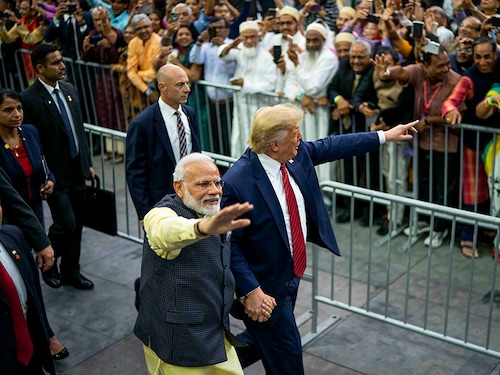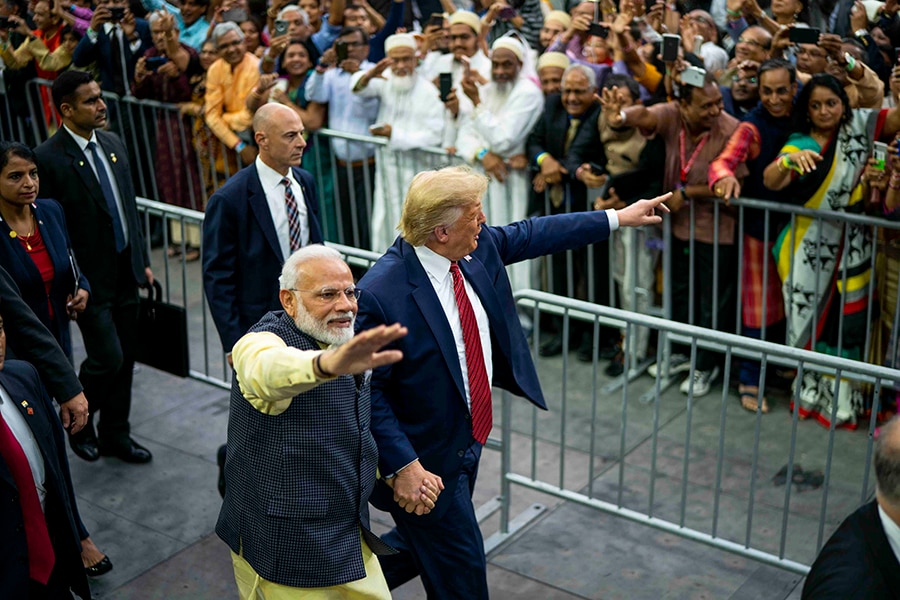At Howdy Modi, Trump plays second fiddle
The rally brought together two leaders with similar styles. Both rose to power by embracing right-wing populism. Both presented voters with a vision to make their respective countries "great again," a


 Prime Minster Narendra Modi of India, left, holds President Donald Trump"s hand as they walk through a rally for Modi, at the NRG Stadium in Houston, Sept. 22, 2019. (Doug Mills/The New York Times)HOUSTON — President Donald Trump played second fiddle Sunday to Narendra Modi, prime minister of India, at a boisterous cultural rally in which the U.S. president was technically just an invited guest.
Prime Minster Narendra Modi of India, left, holds President Donald Trump"s hand as they walk through a rally for Modi, at the NRG Stadium in Houston, Sept. 22, 2019. (Doug Mills/The New York Times)HOUSTON — President Donald Trump played second fiddle Sunday to Narendra Modi, prime minister of India, at a boisterous cultural rally in which the U.S. president was technically just an invited guest.
But never one to let a good crowd go to waste, Trump treated the giant gathering at NRG Stadium in Houston as his own, declaring that “you have never had a better friend as president than President Donald Trump, that I can tell you.”
Tens of thousands of Indian Americans gathered to celebrate the recent reelection of India’s fiery populist leader at an event cheekily called “Howdy, Modi!” Big screens throughout the stadium displayed the face of the prime minister, who arrived to thunderous cheers on a red carpet.
There were no Trump signs in the crowd, as there would be at one of his “Make America Great Again” rallies. And the president mostly stuck to his prepared remarks as the crowd of mostly Indian Americans responded largely with polite applause.
Trump praised Modi, marveling that some 600 million people voted in India’s recent elections. “That’s a lot of people,” the president said, adding that Indian Americans enrich the culture of the United States and that the two nations are “grounded in our common values.”
But he mostly seized on his own rally themes, bragging about slashing regulations, lowering unemployment, implementing a tax cut and hardening the nation’s borders against “those who would threaten our security.”
“There are those in Washington who would raid your health care to fund free benefits to those who enter our country illegally,” he said, previewing his attacks on Democrats during the presidential campaign. “I will never allow politicians to take away your health care or give it to illegal immigrants.”
The rally brought together two leaders with similar styles. Both rose to power by embracing right-wing populism, portraying themselves as champions of the masses fighting against an entrenched establishment. Both presented voters with a vision to make their respective countries “great again,” and both have fanned tensions along religious, economic and social fault lines.
Modi, who is in the United States for a week largely to attend the United Nations General Assembly in New York, won a landslide reelection in May. But Trump and Modi are also both polarizing figures among the people they lead. While many Indians see Modi as a strong, decisive leader, a small but vocal minority say he is becoming an autocrat, rapidly consolidating power, going after political enemies inside his country and sowing division between Hindus and Muslims.
In the United States, Trump is preparing to run for reelection in a bitterly divided country with polls regularly showing him receiving well short of 50% support. His participation in Sunday’s rally with Modi offered a chance to woo a constituency — the 4 million U.S. residents of Indian descent — whose support could prove helpful.
Modi delivered in English an over-the-top introduction of Trump, declaring that the president’s name is “familiar to every person on the planet” and “comes up in almost every conversation in the world on global politics.”
Standing next to Modi, the president beamed with pleasure as the prime minister delivered a twist on his own election slogan: “Abki baar Trump sarkar” or “This time, a Trump government.”
But earning votes from Indian Americans will not be easy for Trump, even with Modi by his side.
Indian Americans have supported both Democrats and Republicans in the past, though they have gravitated away from Trump’s party more recently. Although the president’s tax and economic policies appeal to many Indians, his tough stance on immigration, including legal immigrants from India, has caused great angst, especially in Silicon Valley, which relies heavily on Indian workers who come on H-1B visas.
An overwhelming majority of Indian American voters are registered as Democrats and voted for Hillary Clinton in 2016, according to the Asian American Legal Defense and Education Fund.
M.R. Rangaswami, founder of Indiaspora, a group that tries to organize Indian Americans, said events like Sunday’s rally help the community become more relevant in the United States. He said Trump’s appearance here was an opportunity to increase his 14% showing among Indian Americans in 2016.
“He could hope he could change some minds,” Rangaswami said. “It could happen.”
Trump crowed last week that his decision to join Modi at the event Sunday enlarged the crowd at the stadium, which can hold up to about 70,000 people.
“I have a very good relationship with Prime Minister Modi. By the way, great relationship with Pakistan and with India,” Trump told reporters on Air Force One several days before the Modi event. “But he’s got a big crowd coming, and I guess the crowd just got a lot bigger because they just announced — he asked would I go, and I will go.”
Trump’s appearance at the event, which was followed by a stop with the Australian prime minister at an Ohio recycled packaging plant owned by an Australian company, comes as his administration is finalizing plans for a modest trade deal with India, a step that would help resolve earlier tensions between Trump and Modi over India’s trade balance with the United States and other trade issues.
The trade agreement, which could be finalized by the two leaders as soon as this week, is expected to help U.S. farmers and manufacturers by eliminating Indian restrictions on electronics, medical devices and a few agricultural goods. In return, Trump would restore a special trade status for developing countries, something the president stripped from India this year.
Resolving a nettlesome trade dispute with India presents Trump with an opportunity for a public relations victory amid increasing frustration over his global trade wars with China and other countries.
Modi, 69, is at his best outside India. He has prioritized, more than any other Indian leader in recent decades, India’s brand around the world and projecting an image of a muscular India, an emerging superpower. He travels all across Asia, he was the first Indian prime minister to visit Israel, he has journeyed across Africa and during a visit to New York in 2014 he packed Madison Square Garden with ecstatic crowds cheering: “Modi! Modi! Modi!”
He has come a long way. Years ago, he was banned by U.S. authorities from even entering the United States because of allegations that as chief minister in Gujarat in the early 2000s he was responsible for an explosion of religiously driven violence that claimed more than 1,000 lives, most of them Muslim.
The goal of this trip is to attract investment to India, and there is a little extra urgency: India’s economy is suffering its biggest downturn in years. Modi is also eager to shore up diplomatic support. But a controversy threatens to cast a shadow over his visit.
Human rights groups and three Nobel Peace Prize winners have criticized the Bill & Melinda Gates Foundation for a prestigious award they plan to bestow upon Modi this week. Peace activists said that under Modi’s leadership, “India has descended into dangerous and deadly chaos that has consistently undermined human rights.”
A group of protesters gathered in Houston on Sunday to denounce Modi.
But Modi has typically drawn strong support from the Indian diaspora, even those who disagree with some of his domestic policies, because he has been so successful at burnishing India’s image on the world stage.
First Published: Sep 23, 2019, 11:07
Subscribe Now